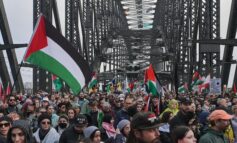The lives of 10,000 Palestinians trapped within West Bank enclaves — cut off from Israel to the west by the Green Line and separated from the West Bank proper to the east by the barrier — have been ruined socially and economically, with their education disrupted and their livelihoods destroyed or seriously damaged.
Some have died or been close to it while waiting for medical treatment as ambulances are turned back at Israeli checkpoints or delayed for hours while medical personnel raced to fulfill increasingly strict criteria for permits to cross the barrier into Israel or to a hospital elsewhere in the West Bank. A few months back Kamala Kabaha, 80, died at the notorious Rihan checkpoint — infamous for its lengthy delays — which separates the northern West Bank village of Bartaa Sharqiya, located in the Jenin area enclave, from the remainder of the Jenin governate. She had suffered a heart attack earlier in the day. The ambulance that set out from Jenin Hospital on the other side of the wall reached Kabaha after being turned back twice. On its return trip to the hospital the ambulance was held up a third time, at Rihan checkpoint, because the dying woman did not have a permit. Kabaha died waiting in the ambulance. Rihan checkpoint is where another member of the Kabaha tribe, Taghreed, 35, in 2003 lost her infant son, Mahmoud, 3, after he and his nine-year-old sister were hit when an Israeli tank fired a single shell at their taxi while it waited to clear security. The girl bears the awful scars. “The Israelis apologized, gave medical assistance and paid us 50,000 NIS (about $13,000)] compensation, but this doesn’t bring Mahmoud back. I can never stop seeing his brains all over the seats of the taxi,” Taghreed told the Middle East Times.
The Green Line was established along the 1949 Armistice Line following the first Arab-Israeli war. Its path followed a route meant to separate the fledgling Jewish State from the Palestinian territories and a future Palestine. Following a wave of devastating suicide bombings carried out by people living in the West Bank the Israeli government in 2002 began building a security barrier to protect Israelis from attacks. The Palestinians, however, accuse the Israelis of using security as a pretext for both a massive land grab and continual human rights abuses. The route of the barrier has significantly deviated from the official and internationally recognized Green Line, and in the process has relocated chunks of fertile West Bank land to Israel’s side. Before the barrier went up some 30 percent of the West Bank had already been expropriated for Israeli settlements, military zones, and nature reserves. A further 10 percent of the West Bank was declared a closed military zone in 2002, trapping 10,000 Palestinian residents — including 2,000 displaced in 1948 by the new State of Israel — as the snaking construction veered sharply into Palestinian territory. The barrier has had a damaging impact on the socio-economic conditions of other West Bankers. Some have not been able to get Israeli security permits to go to their workplaces in Israel, while farmers find themselves cut off from their regular markets to sell their produce, or from their own farmland, some of which has been snatched for the barrier. Significantly many of the affected Palestinians are not interested in going to Israel at all, but only want to travel within West Bank territory — to work or to visit families. These areas are now often located in enclaves within West Bank territory and are geographically separate from Israel. Despite the checkpoints and other travel restrictions within the West Bank itself the land belongs to Palestinians under international law and is part and parcel of a future Palestinian state, according to numerous U.N. Security Council resolutions. One U.N. report says that one-in-five farmers have gone bankrupt by the travel restrictions as only 18 percent of the 30,000 people who used to work the land have been able to obtain from Israel the required “visitor” permits to reach their lands trapped within the enclaves. Some 3,000 people have given up trying to get permits after repeated refusals. More humiliating still is that everyone over the age of 16 — even if they were born within enclaves — must apply for “permanent resident” permits. But for Bartaa’s 5,000 residents, the situation is even tougher. Not only are they unable to cross the Green Line to the west of their village to enter Israel but many are unable to cross the barrier to the east of their village to access the rest of the West Bank. They are literally trapped within their enclave. For closed area communities such as Bartaa, services are generally located on the east side of the barrier, meaning that the sick, children, and workers have to pass through gates to reach health services, schools, and workplaces. Additionally, the Israeli Defense Forces (IDF) are now demanding that national staff of U.N. agencies apply for special permits to enter the closed area between the barrier and the Green Line in the northern West Bank. This move is contrary to international rules regarding the movement of U.N. personnel. But by doing so they have virtually stopped U.N. staff from providing food and emergency aid to suffering Palestinians there. An Israeli spokesman told the Middle East Times that Palestinians who’ve had their land expropriated were entitled to financial compensation. He also said the majority of permit applicants were approved unless the applicant was deemed a security threat. By deviating significantly into Palestinian territory, the barrier has created a new geographical and bureaucratic reality for hundreds of thousands of Palestinians in the northern West Bank. In the Jenin, Tulkarm, Qalqiliya, and Salfit districts, the land between the barrier and the Green Line was declared closed by military order in October 2003.
Reprinted from Middle East Times.





Leave a Reply